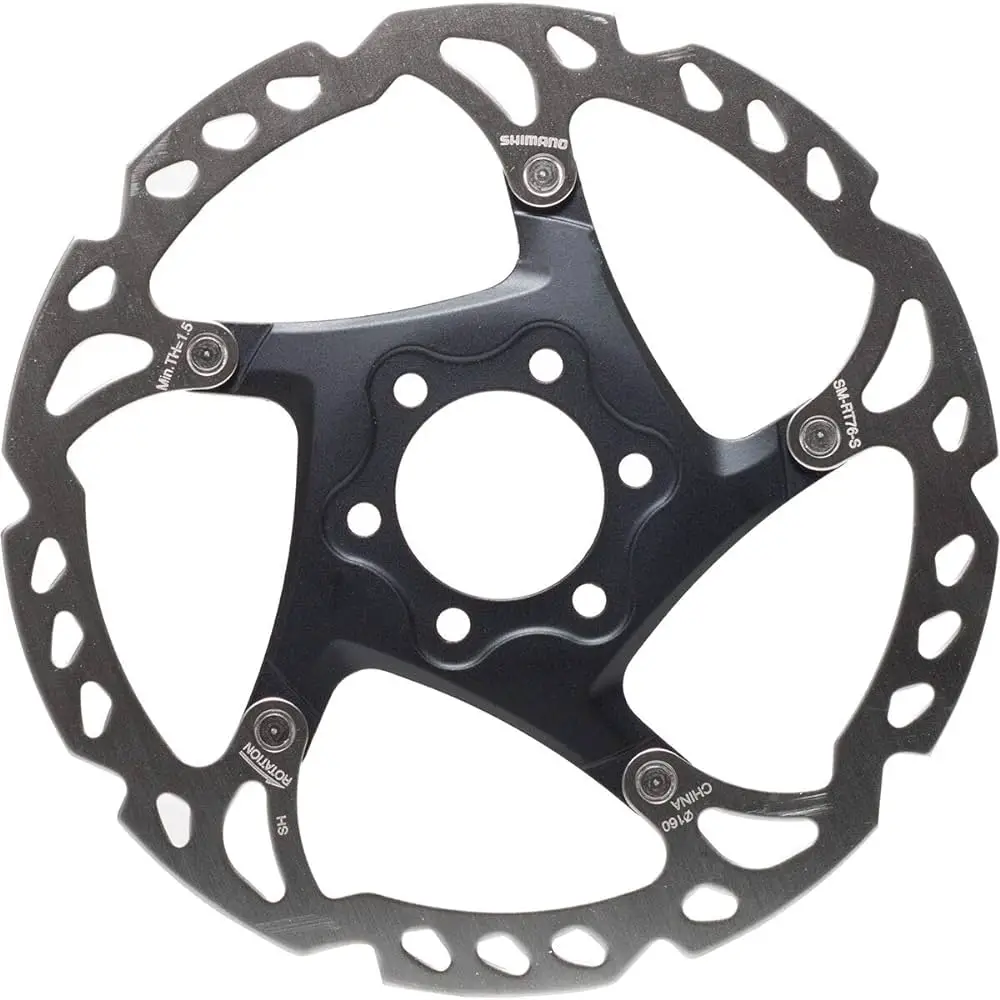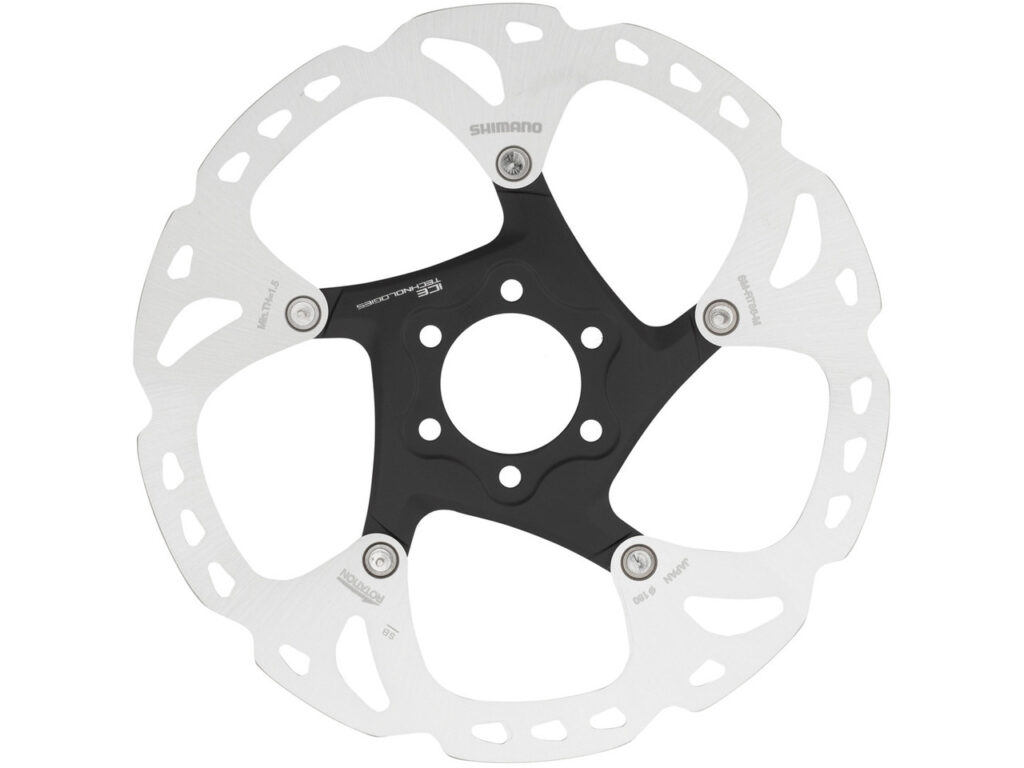Shimano RT76 and RT86 are two popular disc brake rotors designed for mountain bikes. These rotors are known for their durability, performance, and reliability on the trails. Choosing the right rotor can greatly enhance your braking power and control, giving you the confidence to tackle any terrain.
Overview of Shimano RT76 and RT86 Disc Brake Rotors

Shimano RT76: The RT76 disc brake rotor is a reliable choice for riders who value durability and affordability. Constructed with a sturdy 3-layer stainless steel/aluminum/stainless steel sandwich structure, the RT76 offers excellent heat dissipation and resistance to warping. This rotor also features an easy-to-install six-bolt mounting system, making it compatible with a wide range of hubs. The RT76 is available in various sizes, allowing you to choose the one that suits your bike’s needs.
Shimano RT86: The RT86 disc brake rotor is an upgrade from the RT76, offering improved performance and heat management. It features a two-piece construction with an aluminum core attached to a stainless steel braking surface. This design enhances heat dissipation, reducing the risk of brake fade during long descents. The RT86 also utilizes Shimano’s patented Ice Technology, which incorporates cooling fins to further enhance heat dissipation and provide consistent braking performance. With its six-bolt mounting system, the RT86 rotor is compatible with most mountain bike hubs. It comes in various sizes to fit different bikes.
Comparison: When comparing the RT76 and RT86 disc brake rotors, several factors come into play:
Heat Dissipation: The RT86 excels in heat management with its two-piece design and Ice Technology, making it the superior choice for riders who frequently tackle long and steep descents. The RT76, while still offering good heat dissipation, may not perform as effectively under extreme conditions.
Weight: The RT76 is slightly lighter than the RT86 due to its simpler construction. This weight advantage may be desirable for riders who prioritize climbing and acceleration.
Price: The RT76 is generally more affordable than the RT86, making it a budget-friendly option for riders who still want reliable and durable braking performance.
Conclusion: Both the Shimano RT76 and RT86 disc brake rotors are excellent choices for mountain bikers. The RT76 offers solid performance at an affordable price, while the RT86 provides enhanced heat management and overall performance, albeit at a slightly higher cost. Ultimately, the choice between the two will depend on your riding style, terrain, and budget. Whichever rotor you choose, you can trust in Shimano’s reputation for quality and innovation in cycling components. So get out there, hit the trails, and enjoy the confident stopping power that these rotors provide.
Shimano RT76 Disc Brake Rotor
When it comes to cycling, having reliable brakes is essential for the safety and performance of the rider. One of the top choices for disc brake rotors in the market is the Shimano RT76. This disc brake rotor is known for its durability, performance, and excellent braking power. Let’s take a closer look at its specifications, features, and how it compares to other disc brake rotors.
Specifications and Features of the Shimano RT76
The Shimano RT76 disc brake rotor is designed for mountain biking and is available in various sizes to fit different bikes. Here are some key specifications and features of the Shimano RT76:
- Material: The RT76 is made from durable stainless steel that provides reliable performance and resists heat buildup, ensuring consistent braking power even on long descents.
- Design: It features a three-layer sandwich structure with an aluminum core and stainless steel outer layers. This construction enhances both strength and heat dissipation, resulting in better performance and durability.
- Mounting: The RT76 utilizes a six-bolt mounting system, which is compatible with most mountain bike hubs. This allows for easy installation and compatibility with a wide range of disc brake setups.
- Weight: The Shimano RT76 is relatively lightweight compared to other disc brake rotors in its class. This lightweight design reduces rotational inertia, improving overall bike performance and responsiveness.
Performance and Braking Power of the Shimano RT76
When it comes to performance, the Shimano RT76 delivers excellent braking power and consistent performance in various conditions. The stainless steel construction and three-layer sandwich structure allow for efficient heat dissipation, reducing the risk of brake fade.
The RT76’s design also ensures reliable stopping power, even in wet or muddy conditions. The six-bolt mounting system provides a secure connection between the rotor and the hub, resulting in consistent and precise braking.
Comparison with other Disc Brake Rotors
In comparison to other disc brake rotors, such as the Shimano RT86, the RT76 offers similar performance and braking power. The main difference lies in the construction and weight.
The Shimano RT86 features an Ice Tech design, which incorporates an aluminum core with cooling fins. This design helps dissipate heat even more effectively, resulting in improved braking performance during long descents. However, the RT86 is slightly heavier than the RT76 due to the additional cooling fins.
Ultimately, the choice between the Shimano RT76 and RT86 depends on individual preferences and specific biking needs. Riders looking for lightweight and reliable performance may opt for the RT76, while those seeking maximum heat dissipation and performance in extreme conditions might choose the RT86.
In conclusion, the Shimano RT76 disc brake rotor is a popular choice among cyclists for its durability, performance, and excellent braking power. Its stainless steel construction, lightweight design, and compatibility with various disc brake setups make it a reliable option for mountain biking. Whether you choose the RT76 or the RT86, both options are excellent choices for enhancing your cycling experience and ensuring your safety on the roads or trails.
Shimano RT76 vs RT86: Choosing the Right Disc Brake Rotor
When it comes to choosing the right disc brake rotor for your bike, Shimano is a name that stands out for its reputation and quality. Two popular options from Shimano are the RT76 and RT86 disc brake rotors. In this article, we will compare these two options to help you make an informed decision.
Specifications and Features of the Shimano RT86
The Shimano RT86 disc brake rotor is known for its exceptional performance and durability. It features a 6-bolt mounting system and comes in various sizes, including 160mm, 180mm, and 203mm. The RT86 rotor is made with high-quality stainless steel, providing excellent heat dissipation and corrosion resistance.
One of the standout features of the RT86 is the Ice-Tech design. This technology incorporates a three-layer sandwich structure, consisting of an aluminum core sandwiched between two stainless steel outer layers. This design significantly improves heat dissipation, reducing the risk of brake fade and improving overall braking performance.

Performance and Braking Power of the Shimano RT86
The Shimano RT86 rotor excels in delivering consistent and reliable braking power, even in demanding conditions. The Ice-Tech construction effectively dissipates heat, keeping the rotor cool and preventing brake fade, which is vital for long descents or aggressive riding.
The RT86 rotor also provides strong and progressive braking, allowing riders to modulate their braking force with precision. This is especially important for technical trails or when navigating tight corners.
Comparison with other Disc Brake Rotors
In comparison to the Shimano RT76 disc brake rotor, the RT86 offers several advantages. The Ice-Tech construction of the RT86 rotor improves heat dissipation, which is especially beneficial for riders who frequently encounter demanding terrains or engage in prolonged braking.
Another notable difference is the design of the braking surface. The RT86 features a slightly thicker braking surface, which enhances durability and wear resistance. This makes it a preferred choice for riders who require reliable stopping power over extended periods.
Furthermore, the RT86 rotor has gained a reputation for smooth and quiet operation. This is attributed to the precision manufacturing process and the use of high-quality materials.
In summary, the Shimano RT86 disc brake rotor is a top choice for riders seeking reliable braking performance, durability, and heat management. Its Ice-Tech construction and high-quality materials set it apart from the RT76 rotor. However, riders with less aggressive needs may find the RT76 rotor to be a suitable and cost-effective option.
Ultimately, the choice between the Shimano RT76 and RT86 disc brake rotors will depend on your specific riding needs and preferences. Consulting with a knowledgeable bike mechanic or experienced riders can provide further insight into which rotor would best suit your requirements. Remember, when it comes to your safety and performance on the trails, investing in a high-quality disc brake rotor is crucial.
Factors to Consider
When it comes to choosing the right disc brake rotor for your bike, it’s essential to consider various factors that can impact your riding experience. Two popular options in the market are the Shimano RT76 and RT86. Let’s dive into the key factors that differentiate these two rotor models.
Weight, Durability, and Heat Dissipation
Weight: The weight of a disc brake rotor plays a significant role in your bike’s overall performance. The Shimano RT86 rotor is slightly lighter than the RT76, making it a preferred choice for riders who prioritize weight reduction.
Durability: Both the RT76 and RT86 rotors are constructed using high-quality materials for enhanced durability. However, the RT86 rotor features Ice-Tech technology, which includes an aluminum core sandwiched between stainless steel layers. This design improves heat dissipation and enhances overall rotor durability, making it more resistant to wear and warping.
Heat Dissipation: Heat dissipation is crucial for maintaining consistent braking performance during long and intense rides. The Ice-Tech technology used in the RT86 rotor allows for efficient heat dissipation, reducing the risk of brake fade and ensuring reliable stopping power.
Compatibility and Installation
Compatibility: Both the RT76 and RT86 rotors are compatible with Shimano disc brake systems. However, it’s important to ensure that the rotor diameter matches the specific brake caliper model you’re using.
Installation: The installation process for both rotors is straightforward and similar. They come with a lockring that easily threads onto the hub, securing the rotor in place. It’s crucial to properly align the rotor and ensure it sits flat against the hub to avoid any rubbing or noise issues.
Cost and Value for Money
Cost: The Shimano RT86 rotor is generally priced slightly higher than the RT76. This price difference can be attributed to the added features and enhanced performance of the RT86 rotor, such as its Ice-Tech technology.
Value for Money: While the RT86 rotor may have a higher price tag, it offers exceptional value for money due to its durability and improved heat dissipation properties. If you frequently ride in challenging conditions or engage in intense riding activities, the RT86 rotor’s performance benefits may justify the higher price.
In conclusion, choosing between the Shimano RT76 and RT86 rotors depends on your specific needs and preferences. Both options deliver reliable braking performance, but the RT86 offers additional features like improved heat dissipation and enhanced durability. Consider factors such as weight, durability, heat dissipation, compatibility, installation ease, cost, and value for money before making your decision
Comparison between Shimano RT76 and RT86 Disc Brake Rotors
Shimano disc brake rotors are known for their reliability and performance in the cycling industry. Two popular options are the RT76 and RT86 rotors. Let’s compare these two to help you make an informed decision.
Heat Dissipation
The RT76 rotor features a two-piece design with an aluminum core and a steel braking surface. This design provides excellent heat dissipation, preventing the build-up of heat that can cause brake fade during intense rides.
On the other hand, the RT86 rotor uses Shimano’s Ice-Tech technology. It incorporates an aluminum core sandwiched between two stainless steel outer layers. This construction enhances heat dissipation even further, resulting in better braking performance in demanding conditions.
Weight and Durability
The RT76 rotor weighs approximately 174g, while the RT86 rotor weighs slightly more at around 182g. The additional weight is due to the Ice-Tech technology in the RT86 rotor. However, both rotors are lightweight compared to many other options in the market.
In terms of durability, both rotors have a similar lifespan. They are designed to withstand the rigors of off-road riding and provide consistent braking performance over time.
Braking Performance
Both the RT76 and RT86 rotors deliver reliable and consistent braking power. However, the Ice-Tech technology in the RT86 rotor provides an added advantage. The aluminum core acts as a heat sink, effectively dissipating heat and reducing the chances of brake fade during long descents.
Price
The price difference between the RT76 and RT86 rotors is generally minimal. The RT86 rotor is slightly more expensive due to the additional Ice-Tech technology. However, considering the enhanced performance and durability it offers, the RT86 rotor is worth the investment for serious cyclists.
Final Thoughts and Recommendations
Both the Shimano RT76 and RT86 disc brake rotors are excellent choices for cyclists of different skill levels. The RT76 rotor provides reliable braking performance with its two-piece design, while the RT86 rotor offers superior heat dissipation and overall performance with its Ice-Tech technology.
If you frequently ride in challenging terrain or participate in long descents, the RT86 rotor is recommended for its enhanced heat dissipation capabilities. However, if your rides consist of more moderate terrain, the RT76 rotor will still provide reliable braking power at a slightly lower cost.
Ultimately, the choice between the Shimano RT76 and RT86 rotors will depend on your specific cycling needs and budget. Whichever option you choose, you can trust Shimano’s reputation for quality and reliability in their disc brake rotors.

